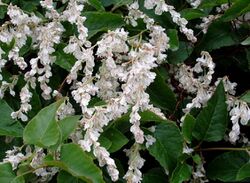Biology:Polygonoideae
| Polygonoideae | |
|---|---|

| |
| Fallopia baldschuanica | |
| Scientific classification | |
| Kingdom: | Plantae |
| Clade: | Tracheophytes |
| Clade: | Angiosperms |
| Clade: | Eudicots |
| Order: | Caryophyllales |
| Family: | Polygonaceae |
| Subfamily: | Polygonoideae Arn.[1] |
| Tribes and genera | |
|
See text. | |
Polygonoideae is a subfamily of plants in the family Polygonaceae. It includes a number of plants that can be highly invasive, such as Japanese knotweed, Reynoutria japonica, and its hybrid with R. sachalinensis, R. × bohemica. Boundaries between the genera placed in the subfamily and their relationships have long been problematic, but a series of molecular phylogenetic studies have clarified some of them,[2][3][4][5][6][1] resulting in the division of the subfamily into seven tribes.[1]
Taxonomy
Phylogeny
A 2015 molecular phylogenetic study suggested that the genera and tribes in Polygonoideae were related as shown in the following cladogram.[1]
| Polygonoideae |
| ||||||||||||||||||||||||||||||||||||
Rumex included Emex, and Fallopia was not monophyletic, with some species placed outside the main group in the tribe Polygoneae, and some others grouping with Pteroxygonum, placed in the tribe Pteroxygoneae.[1]
Genera
Some of the boundaries between the genera are not settled (As of February 2019); in particular, Fallopia is at least paraphyletic.[1] A 2011 classification divided the subfamily into five tribes, Calligoneae, Fagopyreae, Persicariae, Polygoneae and Rumiceae, leaving some genera unplaced.[3] A 2015 molecular phylogenetic study added two new tribes accommodating these genera, Oxygoneae and Pteroxygoneae. Genera and their tribal placement accepted in the 2015 study are shown below.[1]
- Tribe Calligoneae C.A.Mey
- Tribe Fagopyreae Yonek.
- Tribe Oxygoneae T.M.Schust. & Reveal
- Tribe Persicariae Dumort.
- Tribe Polygoneae Rchb.
- Tribe Pteroxygoneae T.M.Schust. & Reveal
- Tribe Rumiceae Dumort.
Many species in the subfamily have at one time or another been placed in different genera; for example the invasive Japanese knotweed is currently in the genus Reynoutria, but has been in Polygonum and Fallopia.[7]
References
- ↑ 1.0 1.1 1.2 1.3 1.4 1.5 1.6 Schuster, Tanja M.; Reveal, James L.; Bayly, Michael J.; Kron, Kathleen A. (2015), "An updated molecular phylogeny of Polygonoideae (Polygonaceae): Relationships of Oxygonum, Pteroxygonum, and Rumex, and a new circumscription of Koenigia", Taxon 64 (6): 1188–1208, doi:10.12705/646.5, https://www.researchgate.net/publication/288889005_An_updated_molecular_phylogeny_of_Polygonoideae_Polygonaceae_Relationships_of_Oxygonum_Pteroxygonum_and_Rumex_and_a_new_circumscription_of_Koenigia
- ↑ Sanchez, A.; Schuster, T.M.; Kron, K.A. (2009), "A largescale phylogeny of Polygonaceae based on molecular data", International Journal of Plant Sciences 170: 1044–1055, doi:10.1086/605121
- ↑ 3.0 3.1 Sanchez, A.; Schuster, T.M.; Burke, J.M.; Kron, K.A. (2011), "Taxonomy of Polygonoideae (Polygonaceae): A new tribal classification", Taxon 60: 151–160
- ↑ Schuster, T.M.; Wilson, K.L.; Kron, K.A. (2011), "Phylogenetic relationships of Muehlenbeckia, Fallopia and Reynoutria (Polygonaceae) investigated with chloroplast and nuclear sequence data", International Journal of Plant Sciences 172: 1053–1066, doi:10.1086/661293
- ↑ Schuster, T.M.; Reveal, J.L.; Kron, K.A. (2011), "Evolutionary Relationships within Polygoneae (Polygonaceae: Polygonoideae)", Taxon 60: 1653–1666, cited in (Schuster Reveal)
- ↑ Fan, D.-M.; Chen, J.-H.; Meng, Y.; Wen, J.; Huang, J.-L.; Yang, Y.-P. (2013), "Molecular phylogeny of Koenigia L. (Polygonaceae: Persicarieae): Implications for classification, character evolution and biogeography.", Molecular Phylogenetics and Evolution 69: 1093–1100, doi:10.1016/j.ympev.2013.08.018
- ↑ "Reynoutria japonica Houtt.". Plants of the World Online. Royal Botanic Gardens, Kew. https://powo.science.kew.org/taxon/urn:lsid:ipni.org:names:435655-1. Retrieved 2019-02-25.
Wikidata ☰ {{{from}}} entry
 |

